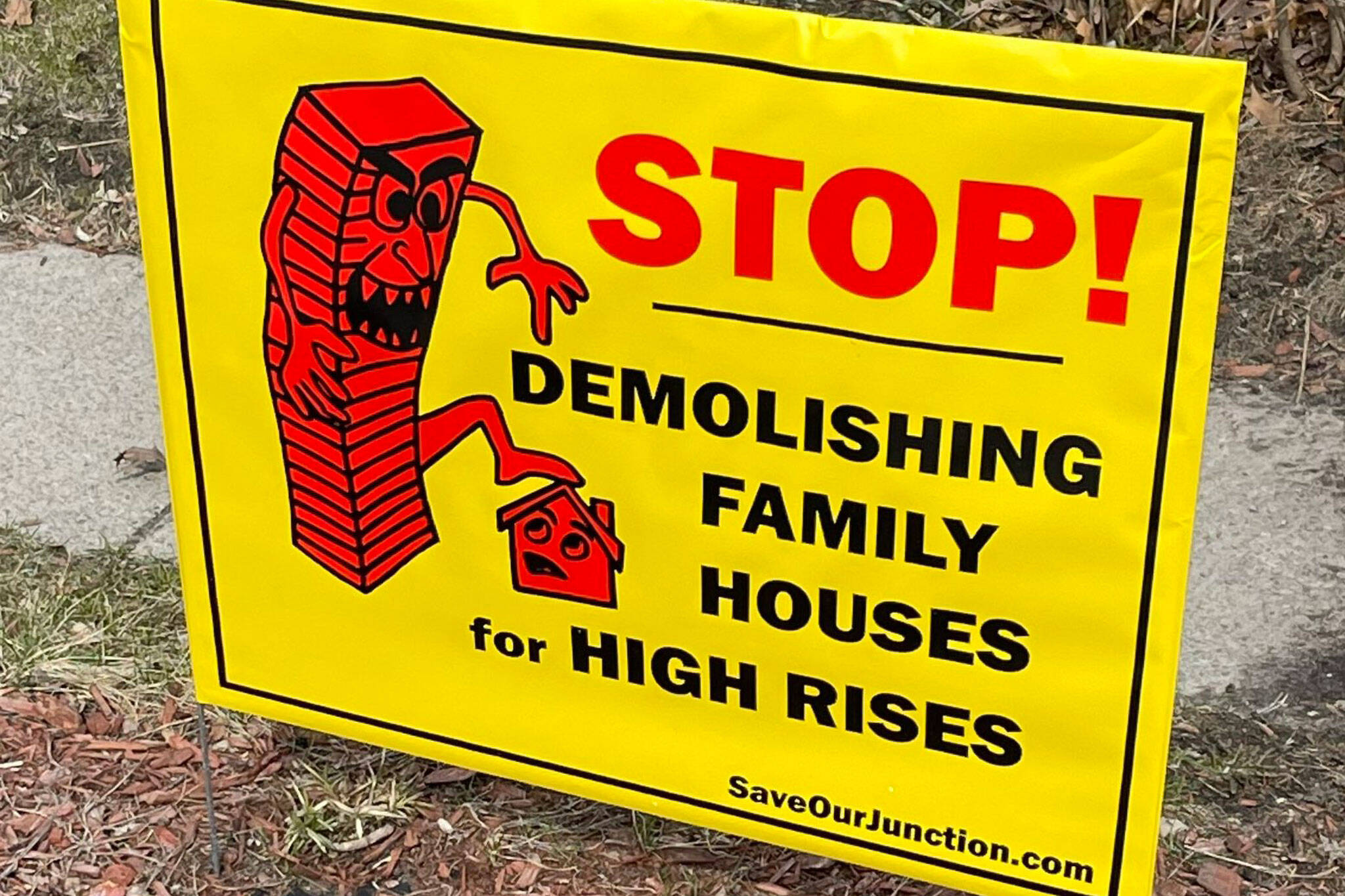
Signs are depicting Toronto development proposals as literal monsters to fight housing
Toronto is in a housing crisis, and real estate industry experts keep stressing that the best way to escape is through actually getting shovels in the ground and building up the supply of homes.
But for every developer championing a new build, there's usually at least one community group fighting to stop it.
Community organizations play a central role in resisting new developments, using all kinds of doom and gloom campaigns to drum up support for their causes. Fear is an age-old tactic for these not-in-my-backyard (or NIMBY) types. Like representing high-rise buildings as literal monsters.
That's exactly the card being played by one community organization known as Save Our Junction, passing out lawn signs in the West Junction neighbourhood that show a tall building anthropomorphized to snuff out a helpless single-family home like a discarded cigarette.
It is the Spring-Time of a Council Election Year in #TOPoli... that magical quadrennial season when the crazy #NIMBY lawn-signs start to bloom on lawns around Toronto... 🌞https://t.co/i6S8sukf5F
— HousingNowTO (@HousingNowTO) April 2, 2022
Sean Hertel, an urban planner and lecturer at various universities, came across the sign on the lawn of a private home in The Junction. He tells blogTO that "the sign just goes to show you the emotions are high right now."
Save Our Junction, identifies as "a community of resident renters, home owners, apartment dwellers and landlords of Toronto’s West Junction Neighbourhood."
Its website claims to be against what the organization describes (in all caps for effect) as "DESTRUCTIVE DEVELOPMENT," claiming that building mid-rise housing in their neighbourhood "reduces the quality of life for residents" and "is NOT the answer to the affordable housing crisis," neglecting to offer any alternative solutions in its place.
It's clear from their justification that the organization's main concern is that their own neighbourhood is on the verge of (gasp) change to support more residents. And they're using imagery of scary monsters to try and fight any solutions to the housing crisis that encroach on their exclusive, privileged way of life.
Hertel says, "I tell my students 'planning is a social science,' and that 'city building is emotional because it's personal,'" adding that "this is where we work, this is where we live. It's very personal. So naturally, arguments are going to be heated and energized on both sides."
Hertel says that planners make evidence-based decisions, and "all evidence points to intensification is a good thing." He points out that "It's not just good for people who are in the building industry," with benefits for current and future residents.
Though the Save Our Junction website claims it wants to educate people on "provincial urban intensification dogma versus reality of dwindling urban population," Hertel contends that "The data is very clear that Toronto is hemorrhaging population in its low-density development popularized as the yellow belt."
"The fewer people there are in the neighbourhood, the shops and public services that draw people to that neighbourhood in the first place begin to lose their viability," said Hertel.
It's also worth noting that while the community organization is using an image of a tower crushing a house, the developments planned throughout this area are predominantly mid-rise.
This monster imagery and mischaracterization of height are not new tactics specific to The Junction at all, seen with another recent example characterizing an 18-storey development as a monster threatening to destroy neighbouring buildings.
Fascinated by the ‘monster building’ genre pic.twitter.com/67yJJR5wAV
— David MacMillan (@urbanenergyplan) April 2, 2022
The above example falsely categorizes the proposed building as a skyscraper to rally dissent and obscures the details of the project, which actually maintains a low-rise presence on the streetscape residents claim is under threat.
And it isn't just a Toronto phenomenon either, like this case out of East Culver City in the U.S.
— Schrödinger's Mountain Lion (@schroedinger_) April 3, 2022
Sometimes the monster has teeth, and sometimes it's Bigfoot, but the message is always more or less the same. Big buildings = bad, status quo = good. Needs of the wider community be damned.
...the ‘monster building’ genre is a core tenet of the #NIMBY faithful around North America -- because "Defending your Village from the Beast" is common Fairy-Tale Lore... and anti-housing folks embrace that kind of story-telling in their messaging... pic.twitter.com/Fh7f5br5Xc
— HousingNowTO (@HousingNowTO) April 2, 2022
The neighbourhood-destroying monster genre of signs isn't likely to disappear anytime soon, nor are the NIMBY types that keep leaning on it.
Still, Hertel insists that the issue isn't as black and white as some paint it, saying that "we've constructed all of these binaries, and I don't know if they really exist."
He contends that "I don't know if there's a single fix, and you just can't say 'more supply will solve our affordable housing crisis' any more than you could say that 'new development is destabilizing neighbourhoods.'"
Sean Hertel
Latest Videos
Latest Videos
Join the conversation Load comments







